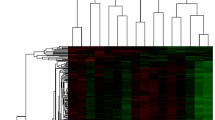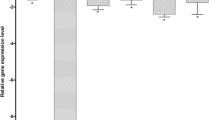Abstract
Purpose
The objective of this study was to investigate the pharmacogenomics and the spatial regulation of global gene expression profiles elicited by cancer chemopreventive agent butylated hydroxyanisole (BHA) in mouse small intestine and liver as well as to identify BHA-modulated nuclear factor-E2-related factor 2 (Nrf2)-dependent genes.
Methods
C57BL/6J (+/+; wildtype) and C57BL/6J/Nrf2(−/−; knockout) mice were administered a single 200 mg/kg oral dose of BHA or only vehicle. Both small intestine and liver were collected at 3 h after treatment and total RNA was extracted. Gene expression profiles were analyzed using 45,000 Affymetrix mouse genome 430 2.0 array and GeneSpring 7.2 software. Microarray results were validated by quantitative real-time reverse transcription-PCR analyses.
Results
Clusters of genes that were either induced or suppressed more than two fold by BHA treatment compared with vehicle in C57BL/6J/Nrf2(−/−; knockout) and C57BL/6J Nrf2 (+/+; wildtype) mice genotypes were identified. Amongst these, in small intestine and liver, 1,490 and 493 genes respectively were identified as Nrf2-dependent and upregulated, and 1,090 and 824 genes respectively as Nrf2-dependent and downregulated. Based on their biological functions, these genes can be categorized into ubiquitination/proteolysis, apoptosis/cell cycle, electron transport, detoxification, cell growth/differentiation, transcription factors/interacting partners, kinases and phosphatases, transport, biosynthesis/metabolism, RNA/protein processing and nuclear assembly, and DNA replication genes. Phase II detoxification/antioxidant genes as well as novel molecular target genes, including putative interacting partners of Nrf2 such as nuclear corepressors and coactivators, were also identified as Nrf2-dependent genes.
Conclusions
The identification of BHA-regulated and Nrf2-dependent genes not only provides potential novel insights into the gestalt biological effects of BHA on the pharmacogenomics and spatial regulation of global gene expression profiles in cancer chemoprevention, but also points to the pivotal role of Nrf2 in these biological processes.




Similar content being viewed by others
Abbreviations
- ARE:
-
antioxidant response element
- BHA:
-
butylated hydroxyanisole
- Mapk:
-
mitogen-activated protein kinase
- Nrf2:
-
nuclear factor-E2 -related factor 2
References
R. Yu, T. H. Tan, and A. N. T. Kong. Butylated hydroxyanisole and its metabolite tert-butylhydroquinone differentially regulate mitogen-activated protein kinases. The role of oxidative stress in the activation of m itogen-activated protein kinases by phenolic antioxidants. J. Biol. Chem.272:28962–28970 (1997).
M. Saito, H. Sakagami, and S. Fujisawa. Cytotoxicity and apoptosis induction by butylated hydroxyanisole (BHA) and butylated hydroxytoluene (BHT). Anticancer Res.23:4693–4701 (2003).
N. Festjens, M. Kalai, J. Smet, A. Meeus, R. Van Coster, X. Saelens, and P. Vandenabeele. Butylated hydroxyanisole is more than a reactive oxygen species scavenger. Cell Death Differ.13:166–169 (2006).
M. Kalai, G. Van Loo, T. Vanden Berghe, A. Meeus, W. Burm, X. Saelens, and P. Vandenabeele. Tipping the balance between necrosis and apoptosis in human and murine cells treated with interferon and dsRNA. Cell Death Differ.9:981–994 (2002).
J. D. Hayes, D. J. Pulford, E. M. Ellis, R. McLeod, R. F. James, J. Seidegard, E. Mosialou, B. Jernstrom, and G. E. Neal. Regulation of rat glutathione S-transferase A5 by cancer chemopreventive agents: mechanisms of inducible resistance to aflatoxin B1. Chem. Biol. Interact.111–112:51–67 (1998).
D. L. McCormick, N. Major, and R. C. Moon. Inhibition of 7,12-dimethylbenz(a)anthracene-induced rat mammary carcinogenesis by concomitant or postcarcinogen antioxidant exposure. Cancer Res.44:2858–2863 (1984).
F. E. Jones, R. A. Komorowski, and R. E. Condon. The effects of ascorbic acid and butylated hydroxyanisole in the chemoprevention of 1,2-dimethylhydrazine-induced large bowel neoplasms. J. Surg. Oncol. 25: 54–60 (1984).
G. M. Williams, M. J. Iatropoulos, and A. M. Jeffrey. Anticarcinogenicity of monocyclic phenolic compounds. Eur. J. Cancer Prev.11(Suppl 2):S101–S107 (2002).
R. Yu, S. Mandlekar, and A. N. T. Kong. Molecular mechanisms of butylated hydroxylanisole-induced toxicity: induction of apoptosis through direct release of cytochrome c. Mol. Pharmacol.58:431–437 (2000).
J. Alam, D. Stewart, C. Touchard, S. Boinapally, A. M. Choi, and J. L. Cook. Nrf2, a Cap’n’Collar transcription factor, regulates induction of the heme oxygenase-1 gene. J. Biol. Chem.274:26071–26078 (1999).
M. McMahon, K. Itoh, M. Yamamoto, S. A. Chanas, C. J. Henderson, L. I. McLellan, C. R. Wolf, C. Cavin, and J. D. Hayes. The Cap’n’Collar basic leucine zipper transcription factor Nrf2 (NF-E2 p45-related factor 2) controls both constitutive and inducible expression of intestinal detoxification and glutathione biosynthetic enzymes. Cancer Res.61:3299–3307 (2001).
R. K. Thimmulappa, K. H. Mai, S. Srisuma, T. W. Kensler, M. Yamamoto, and S. Biswal. Identification of Nrf2-regulated genes induced by the chemopreventive agent sulforaphane by oligonucleotide microarray. Cancer Res.62:5196–5203 (2002).
H. J. Prochaska, M. J. De Long, and P. Talalay. On the mechanisms of induction of cancer-protective enzymes: a unifying proposal. Proc. Natl. Acad. Sci. U. S. A.82:8232–8236 (1985).
W. Li, M. R. Jain, C. Chen, X. Yue, V. Hebbar, R. Zhou, and A. N. Kong. Nrf2 Possesses a redox-insensitive nuclear export signal overlapping with the leucine zipper motif. J. Biol. Chem.280:28430–28438 (2005).
G. Shen, V. Hebbar, S. Nair, C. Xu, W. Li, W. Lin, Y. S. Keum, J. Han, M. A. Gallo, and A. N. Kong. Regulation of Nrf2 transactivation domain activity. The differential effects of mitogen-activated protein kinase cascades and synergistic stimulatory effect of Raf and CREB-binding protein. J. Biol. Chem.279:23052–23060 (2004).
Y. S. Keum, E. D. Owuor, B. R. Kim, R. Hu, and A. N. Kong. Involvement of Nrf2 and JNK1 in the activation of antioxidant responsive element (ARE) by chemopreventive agent phenethyl isothiocyanate (PEITC). Pharm. Res.20:1351–1356 (2003).
C. Chenand and A. N. Kong. Dietary chemopreventive compounds and ARE/EpRE signaling. Free Radic. Biol. Med.36:1505–1516 (2004).
K. Itoh, N. Wakabayashi, Y. Katoh, T. Ishii, K. Igarashi, J. D. Engel, and M. Yamamoto. Keap1 represses nuclear activation of antioxidant responsive elements by Nrf2 through binding to the amino-terminal Neh2 domain. Genes Dev.13:76–86 (1999).
S. Dhakshinamoorthy and A. K. Jaiswal. Functional characterization and role of INrf2 in antioxidant response element-mediated expression and antioxidant induction of NAD(P)H:quinone oxidoreductase1 gene. Oncogene20:3906–3917 (2001).
N. Wakabayashi, A. T. Dinkova-Kostova, W. D. Holtzclaw, M. I. Kang, A. Kobayashi, M. Yamamoto, T. W. Kensler, and P. Talalay. Protection against electrophile and oxidant stress by induction of the phase 2 response: fate of cysteines of the Keap1 sensor modified by inducers. Proc. Natl. Acad. Sci. U. S. A.101:2040–2045 (2004).
X. Yu and T. Kensler. Nrf2 as a target for cancer chemoprevention. Mutat. Res.591:93–102 (2005).
S. Dhakshinamoorthy and A. K. Jaiswal. Small maf (MafG and MafK) proteins negatively regulate antioxidant response element-mediated expression and antioxidant induction of the NAD(P)H:Quinone oxidoreductase1 gene. J. Biol. Chem.275:40134–40141 (2000).
A. N. Kong, R. Yu, W. Lei, S. Mandlekar, T. H. Tan, and D. S. Ucker. Differential activation of MAPK and ICE/Ced-3 protease in chemical-induced apoptosis. The role of oxidative stress in the regulation of mitogen-activated protein kinases (MAPKs) leading to gene expression and survival or activation of caspases leading to apoptosis. Restor. Neurol. Neurosci.12:63–70 (1998).
K. Chan, R. Lu, J. C. Chang, and Y. W. Kan. NRF2, a member of the NFE2 family of transcription factors, is not essential for murine erythropoiesis, growth, and development. Proc. Natl. Acad. Sci. U. S. A.93:13943–13948 (1996).
G. Shen, C. Xu, R. Hu, M. R. Jain, S. Nair, W. Lin, C. S. Yang, J. Y. Chan, and A. N. Kong. Comparison of (−)-epigallocatechin-3-gallate elicited liver and small intestine gene expression profiles between C57BL/6J mice and C57BL/6J/Nrf2 (−/−) mice. Pharm. Res.22:1805–1820 (2005).
G. Shen, C. Xu, R. Hu, M. R. Jain, A. Gopalkrishnan, S. Nair, M. T. Huang, J. Y. Chan, and A. N. Kong. Modulation of nuclear factor E2-related factor 2-mediated gene expression in mice liver and small intestine by cancer chemopreventive agent curcumin. Mol. Cancer Ther.5:39–51 (2006).
W. Lin, G. Shen, X. Yuan, M. R. Jain, S. Yu, A. Zhang, J. D. Chen, and A. N. Kong. Regulation of Nrf2 Transactivation Domain Activity by p160 RAC3/SRC3 and Other Nuclear Co-Regulators. J. Biochem. Mol. Biol.39(3):304–310.
K. I. Borroz, T. M. Buetler, and D. L. Eaton. Modulation of gamma-glutamylcysteine synthetase large subunit mRNA expression by butylated hydroxyanisole. Toxicol. Appl. Pharmacol.126:150–155 (1994).
T. M. Buetler, E. P. Gallagher, C. Wang, D. L. Stahl, J. D. Hayes, and D. L. Eaton. Induction of phase I and phase II drug-metabolizing enzyme mRNA, protein, and activity by BHA, ethoxyquin, and oltipraz. Toxicol. Appl. Pharmacol.135:45–57 (1995).
L. I. McLellan, D. J. Harrison, and J. D. Hayes. Modulation of glutathione S-transferases and glutathione peroxidase by the anticarcinogen butylated hydroxyanisole in murine extrahepatic organs. Carcinogenesis13:2255–2261 (1992).
S. A. Chanas, Q. Jiang, M. McMahon, G. K. McWalter, L. I. McLellan, C. R. Elcombe, C. J. Henderson, C. R. Wolf, G. J. Moffat, K. Itoh, M. Yamamoto, and J. D. Hayes. Loss of the Nrf2 transcription factor causes a marked reduction in constitutive and inducible expression of the glutathione S-transferase Gsta1, Gsta2, Gstm1, Gstm2, Gstm3 and Gstm4 genes in the livers of male and female mice. Biochem. J.365:405–416 (2002).
A. R. Tanaka, K. Tanabe, M. Morita, M. Kurisu, Y. Kasiwayama, M. Matsuo, N. Kioka, T. Amachi, T. Imanaka, and K. Ueda. ATP binding/hydrolysis by and phosphorylation of peroxisomal ATP-binding cassette proteins PMP70 (ABCD3) and adrenoleukodystrophy protein (ABCD1). J. Biol. Chem.277:40142–40147 (2002).
A. S. Verkman. More than just water channels: unexpected cellular roles of aquaporins. J. Cell Sci.118:3225–3232 (2005).
Y. Shi and J. Massague. Mechanisms of TGF-beta signaling from cell membrane to the nucleus. Cell113:685–700 (2003).
R. Vittal, Z. E. Selvanayagam, Y. Sun, J. Hong, F. Liu, K. V. Chin, and C. S. Yang. Gene expression changes induced by green tea polyphenol (−)-epigallocatechin-3-gallate in human bronchial epithelial 21BES cells analyzed by DNA microarray. Mol. Cancer Ther.3:1091–1099 (2004).
G. R. Beck, Jr., B. Zerler, and E. Moran. Gene array analysis of osteoblast differentiation. Cell Growth Differ. 12:61–83 (2001).
L. Yang, K. Yamasaki, Y. Shirakata, X. Dai, S. Tokumaru, Y. Yahata, M. Tohyama, Y. Hanakawa, K. Sayama, and K. Hashimoto. Bone morphogenetic protein-2 modulates Wnt and frizzled expression and enhances the canonical pathway of Wnt signaling in normal keratinocytes. J. Dermatol. Sci. (2006).
H. Motohashi, F. Katsuoka, J. D. Engel, and M. Yamamoto. Small Maf proteins serve as transcriptional cofactors for keratinocyte differentiation in the Keap1-Nrf2 regulatory pathway. Proc. Natl. Acad. Sci. U. S. A.101:6379–6384 (2004).
J. M. Lizcano, S. Alrubaie, A. Kieloch, M. Deak, S. J. Leevers, and D. R. Alessi. Insulin-induced Drosophila S6 kinase activation requires phosphoinositide 3-kinase and protein kinase B. Biochem. J.374:297–306 (2003).
J. Dornand, C. Sekkat, J. C. Mani, and M. Gerber. Lipoxygenase inhibitors suppress IL-2 synthesis: relationship with rise of [Ca++]i and the events dependent on protein kinase C activation. Immunol. Lett.16:101–106 (1987).
M. Ruzzene, A. Donella-Deana, A. Alexandre, M. A. Francesconi, and R. Deana. The antioxidant butylated hydroxytoluene stimulates platelet protein kinase C and inhibits subsequent protein phosphorylation induced by thrombin. Biochim. Biophys. Acta1094:121–129 (1991).
Acknowledgments
The authors are deeply grateful to Mr. Curtis Krier at the Cancer Institute of New Jersey (CINJ) Core Expression Array Facility for his expert assistance with the microarray analyses. The authors are also deeply indebted to Ms. Donna Wilson of the Keck Center for Collaborative Neuroscience, Rutgers University as well as the staff of the Human Genetics Institute of New Jersey at Rutgers University for their great expertise and help with the quantitative real-time PCR analyses. This work was supported in part by NIH grant R01-CA094828.
Author information
Authors and Affiliations
Corresponding author
Additional information
Sujit Nair and Changjiang Xu contributed equally to the present study.
Rights and permissions
About this article
Cite this article
Nair, S., Xu, C., Shen, G. et al. Pharmacogenomics of Phenolic Antioxidant Butylated Hydroxyanisole (BHA) in the Small Intestine and Liver of Nrf2 Knockout and C57BL/6J Mice. Pharm Res 23, 2621–2637 (2006). https://doi.org/10.1007/s11095-006-9099-x
Received:
Accepted:
Published:
Issue Date:
DOI: https://doi.org/10.1007/s11095-006-9099-x




